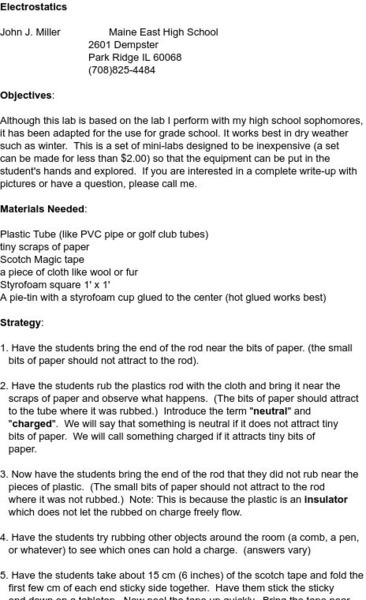Hi, what do you want to do?
Concord Consortium
What Are the Factors That Affect How Strongly Objects Interact With Each Other?
Exploration of models of electric field to explain how charged objects interact with other objects via simulations, practice and activities. Sponsored by Concord Consortium and the CREATE for STEM Institute at Michigan State University.
Famous Scientists
Famous Scientists: Charles Augustin De Coulomb
A short biography about Charles Coulomb, known for developing Coulomb's law, the definition of the electrostatic force of attraction and repulsion.
National High Magnetic Field Laboratory
Magnet Academy: Charles Augustin De Coulomb
Charles-Augustin de Coulomb invented a device, dubbed the torsion balance, that allowed him to measure very small charges and experimentally estimate the force of attraction or repulsion between two charged bodies. The data he obtained...
Concord Consortium
Concord Consortium: Target Game
Steer a charged particle to a target, and observe forces and fields.
Concord Consortium
Concord Consortium: How Electrons Move
Being able to control the movement of electrons is fundamental for making all electronic devices work. Discover how electric and magnetic fields can be used to move electrons around. Begin by exploring the relationship between electric...
The Franklin Institute
Priestley's Physics Project
Learn about Priestley's Electrostatic Machine. There are links that tell about the machine and Priestley himself. There are also resources for teachers and students, including lesson plans and activities.
Concord Consortium
Concord Consortium What Are the Factors That Affect How Strongly Objects Interact With Each Other?
Activity 2 of this module explains How do factors like distance and amount of charge affect interactions between objects? The activity investigates the effect that the distance between two charged objects has on the strength of the...
Science and Mathematics Initiative for Learning Enhancement (SMILE)
Smile: Electrostatics
A teacher lesson plan which includes activities pertaining to common methods of charging objects - induction, conduction, and friction.
Science and Mathematics Initiative for Learning Enhancement (SMILE)
Smile: Electrostatics
From the Science and Mathematics Initiative for Learning Enhancement project at the Illinois Institute of Technology. A teacher lesson plan which includes several Van de Graaff generator demonstrations and some station-style labs. Young...
Science and Mathematics Initiative for Learning Enhancement (SMILE)
Smile: Electrostatic Models
A teacher lesson plan which includes several hands-on activities pertaining to static charge, charge interactions, and the induction process. Students use readily available materials to investigate these concepts. Designed for pre-high...










